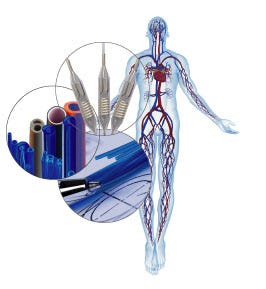How Medical Extrusion is Enabling Optimization of Endovascular Devices
September 19, 2014
The development of vascular access and delivery devices demands careful consideration of the best combination of material and dimensions while accounting for the harsh conditions of the human anatomy.
By Jennifer Fauria and Andrew Taborda
|
Extrusion for new endovascular technologies is challenged by anatomical demands. |
The human vascular system presents uniquely demanding conditions: A high blood pressure environment is paired with elastic smooth muscle tissue, allowing vessels to expand while remaining vulnerable to intimal damage. Engineers developing vascular access and delivery devices, in turn, face the challenge of designing products capable of navigating the demanding environment while sustaining safe and efficacious treatment.
Medical extrusion for devices delivered via arterial access is among the most highly stressed elements in the field of medical device engineering, after all. Extrusion material selection, preparation, and quality process engineering are principal; some tubing wall thicknesses are five times thinner than a human hair and perform at pressures up to 20 and 30 atmospheres. Material failures at this level can compromise catheter performance, potentially affecting both patient safety and procedure time.
To meet these demanding performance requirements, microextrusion for endovascular applications requires a deep understanding of the material chemistry and behavior, along with instrumentation calibrated for extreme precision process control. But it also requires knowledge and use of sophisticated computing systems for real-time data collection and analysis. This expertise, combined with the knowledge of experienced mechanical operators continuously monitoring each extrusion run, make consistent microtubing extrusions with extremely tight tolerances--with walls as thin as 0.001 in--feasible.
Feasibility device development can go through several design revisions to determine the best combination of material and dimensions for the medical application. Optimizing catheter pushability and trackability while maintaining shaft support, for example, ranks equally in importance to promoting lubricity and smooth component transitions to maintain system integrity in combination devices. Another consideration is radiopacity--a crucial element for clinicians navigating tortuous anatomical conditions. Radiopaque marker bands must be precisely applied to the catheter to avoid lumen damage. Shaft extrusion consisting of multilayer tubing plays an important role in device development to meet each of these requirements.
Most often used in over-the-wire implant delivery systems, trilayer extrusions offer weld compatibility and tensile outer layer support while the inner layer material facilitates a low coefficient of friction on the guidewire to enhance clinician tactile feel during an interventional procedure. Tightly controlled tooling, pressures, run speeds and other extrusion parameters are critical to obtaining trilayer tubing optimized for over-the-wire delivery systems; the ideal design is a solid and concentric inner layer for guidewire lubricity bonded to the flexible outer layer by a thin concentric tie layer. Obtaining a balance is of the utmost importance for reducing friction between the guidewire and the tubing, as well as for ensuring consistency and repeatability of welds during production.
Through continuous exploration of innovation and time-acquired engineering expertise, the cause-and-effect relationships between process parameters and process outcomes become finite. The attributes of greatest importance in selecting an extrusion supplier for an endovascular device system is engineering and design support paired with integrated capabilities for tooling, assembly, test, and inspection. Additionally, controlled cleanroom space, audited quality systems, and ISO certification are equally important. Involving an extrusion supplier's engineering team early in the design process best establishes a workable collaboration of expertise in extrusion material science with the end-user application in preparing for the next phases of design review.
Visit Interface Catheter Solutions and other extrusion suppliers at MD&M Minneapolis, October 29-30. |
Jennifer Fauria is the marketing manager at Interface Catheter Solutions.
Andrew Taborda is the technology support engineer at Interface Catheter Solutions.
You May Also Like



